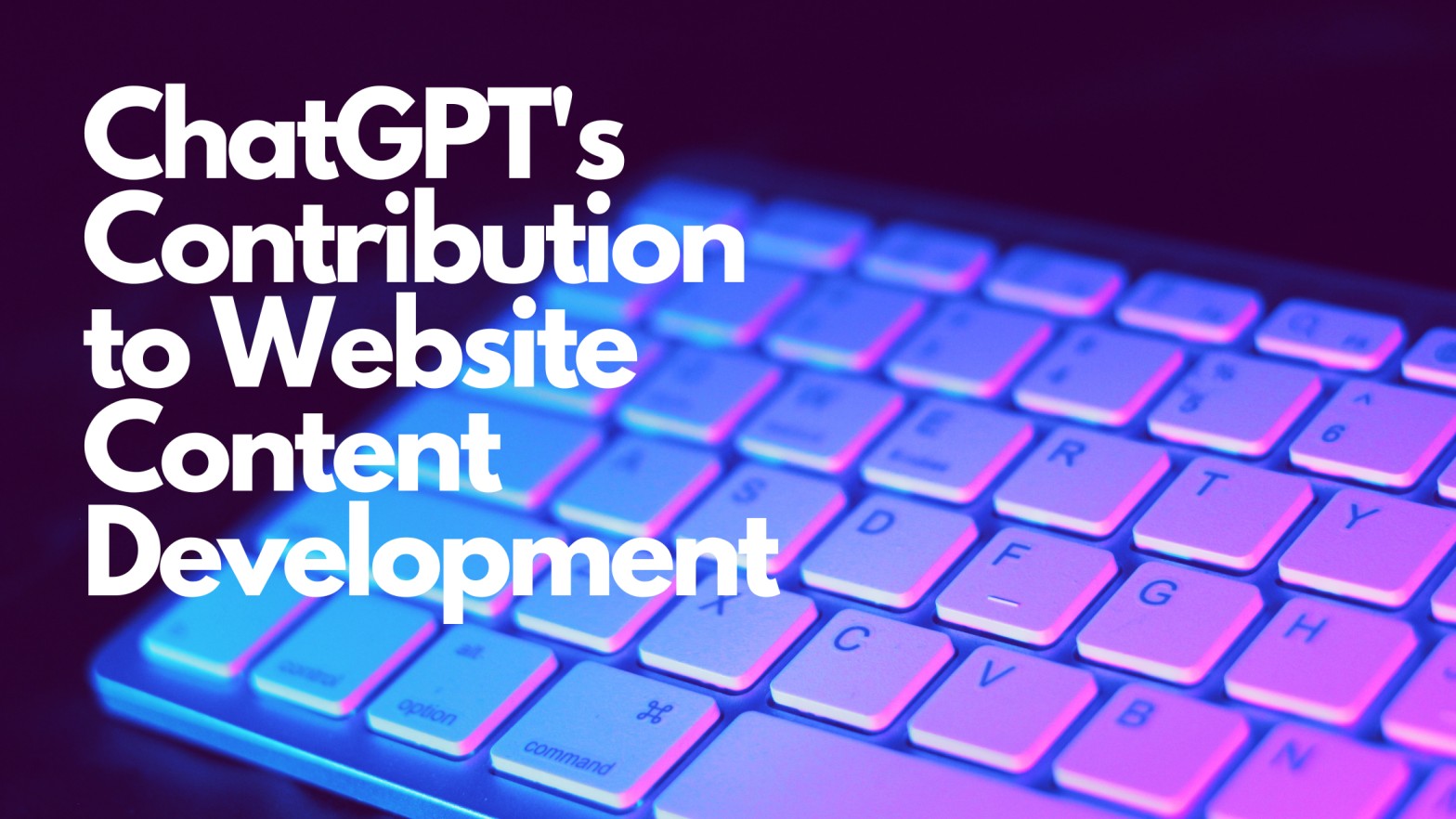ChatGPT is an AI-powered language model developed by OpenAI. It utilizes cutting-edge natural language processing (NLP) techniques to generate human-like text based on the input it receives. With its ability to understand and generate text in a variety of contexts, ChatGPT’s has become a valuable tool for various applications, including content creation for websites.
Website content development plays a crucial role in attracting and engaging online audiences. High-quality content not only improves search engine visibility but also enhances user experience, establishes credibility, and drives conversions. In today’s digital landscape, where content is king, businesses, and individuals strive to create compelling and relevant content to stand out amidst the vast sea of online information. ChatGPT’s capabilities offer new avenues for efficient and effective content creation, revolutionizing the way websites develop and deliver content to their audience.
Understanding ChatGPT
Brief History and Development:
- ChatGPT is developed by OpenAI, a leading artificial intelligence research laboratory.
- It builds upon the foundation laid by previous versions of the GPT (Generative Pre-trained Transformer) model.
- OpenAI continually refines ChatGPT through iterations and updates, enhancing its language understanding and generation capabilities.
Key Features and Capabilities:
- Natural Language Processing (NLP): ChatGPT can understand and generate human-like text in multiple languages.
- Contextual Understanding: It contextualizes input to generate coherent and contextually relevant responses.
- Large-Scale Training Data: Trained on vast amounts of text data from the internet, ChatGPT has broad knowledge across various topics.
- Fine-Tuning Capabilities: Users can fine-tune ChatGPT on specific datasets to tailor its responses for particular applications or industries.
- Continuous Learning: With ongoing updates and improvements, ChatGPT adapts to new language patterns and information, staying up-to-date with evolving language usage.
ChatGPT’s Role in Website Content Creation
Generating Engaging Blog Posts:
Use Cases and Examples:
- ChatGPT can generate blog post drafts on various topics, catering to the interests of the website’s audience.
- It can produce informative, entertaining, or persuasive content depending on the blog’s purpose and target audience.
- Examples include blog posts on technology trends, travel destinations, health tips, and product reviews.
Best Practices:
- Provide clear prompts or guidelines to ensure ChatGPT generates content aligned with the blog’s theme and objectives.
- Review and edit generated content to refine its quality, coherence, and relevance.
- Incorporate engaging elements such as visuals, storytelling, and interactive features to enhance reader engagement.
- Use ChatGPT as a tool to streamline content creation processes, but maintain human oversight to ensure accuracy, authenticity, and adherence to ethical standards.
Crafting Compelling Product Descriptions:
How ChatGPT Enhances Product Descriptions:
- ChatGPT can generate detailed and persuasive product descriptions based on input provided about the product’s features, benefits, and target audience.
- It can tailor descriptions to highlight key selling points, address customer pain points, and evoke emotional responses to drive purchasing decisions.
- ChatGPT’s language generation capabilities enable the creation of unique and compelling product descriptions that resonate with potential buyers.
Case Studies:
Case Study 1: E-commerce Platform
- ChatGPT was used to generate product descriptions for a diverse range of items sold on an e-commerce platform.
- The platform saw an increase in conversion rates and customer engagement after implementing ChatGPT-generated descriptions.
- Customers appreciated the clarity, accuracy, and appeal of the product descriptions, leading to higher sales.
Case Study 2: Tech Gadgets Manufacturer
- A tech gadgets manufacturer utilized ChatGPT to create product descriptions for its latest lineup of devices.
- The descriptive and informative nature of the descriptions contributed to better product understanding among potential buyers.
- ChatGPT-generated descriptions helped the manufacturer differentiate its products in a competitive market, leading to increased brand visibility and sales.
Optimizing SEO Content:
Leveraging ChatGPT for SEO-Friendly Content:
- ChatGPT can assist in generating SEO-friendly content by incorporating relevant keywords, phrases, and semantic structures that align with search engine algorithms.
- It can analyze search trends and user intent to create content that addresses popular queries and topics, thereby improving search engine rankings.
- ChatGPT’s ability to understand context and generate coherent text ensures that the produced content remains engaging and informative while satisfying SEO requirements.
Tips for Effective SEO Content Generation:
- Conduct Keyword Research: Identify relevant keywords and phrases related to your website’s content and target audience.
- Provide Clear Instructions: Give ChatGPT specific instructions on the desired tone, style, and key points to include in the content.
- Optimize Meta Tags and Headings: Ensure that generated content includes optimized meta tags, titles, and headings to improve visibility in search engine results.
- Focus on Quality and Relevance: Emphasize creating high-quality, relevant content that addresses user queries and provides valuable information.
- Regularly Update Content: Keep content fresh and up-to-date to maintain its relevance and appeal to both users and search engines.
- Monitor Performance: Track the performance of generated content using analytics tools to identify areas for improvement and optimization.
Enhancing User Experience with ChatGPT:
Personalized Content Recommendations:
- ChatGPT can analyze user behavior, preferences, and historical data to provide personalized content recommendations.
- By understanding user interests and consumption patterns, ChatGPT can suggest relevant articles, products, or services tailored to individual users’ needs.
- Personalized content recommendations enhance user engagement, increase time spent on the website, and improve overall satisfaction by delivering relevant and valuable content.
Real-time Customer Support through Chatbots:
- ChatGPT-powered chatbots can offer real-time customer support by answering common inquiries, providing product information, and assisting with troubleshooting.
- Through natural language understanding, ChatGPT chatbots can converse with users in a human-like manner, offering personalized assistance and resolving issues efficiently.
- Real-time customer support chatbots enhance user experience by providing instant responses, reducing wait times, and offering 24/7 availability for assistance.
Interactive Elements on Websites:
- ChatGPT can generate interactive elements such as quizzes, polls, surveys, and games to engage users and encourage participation.
- Interactive elements make the website more dynamic and immersive, fostering a sense of involvement and interactivity among users.
- ChatGPT can generate conversational scripts for interactive chatbots or virtual assistants that guide users through various tasks, answer questions, and provide personalized recommendations.
- By incorporating interactive elements, websites can increase user engagement, improve retention rates, and create memorable experiences for visitors.
Ethical Considerations and Challenges:
Ensuring Accuracy and Authenticity:
- ChatGPT-generated content should undergo careful review and validation to ensure accuracy and authenticity, especially when dealing with sensitive or critical information.
- Measures such as fact-checking, source verification, and human oversight are essential to mitigate the risk of misinformation or inaccuracies in generated content.
- Transparency regarding the use of AI-generated content and disclosing the involvement of ChatGPT in content creation can help maintain trust and credibility with users.
Addressing Bias and Misinformation:
- ChatGPT may inadvertently perpetuate biases present in its training data, leading to biased or discriminatory content generation.
- Techniques such as bias detection, mitigation, and fairness testing can help identify and address biases in ChatGPT-generated content.
- Implementing diversity and inclusion measures in training data selection and model development can help reduce biases and ensure more equitable content generation.
Maintaining User Privacy:
- ChatGPT’s use in website content creation raises concerns about user privacy, particularly regarding the collection and processing of personal data.
- Clear privacy policies and consent mechanisms should be in place to inform users about the use of their data and ensure compliance with relevant regulations such as GDPR or CCPA.
- Minimizing the collection of personally identifiable information (PII) and implementing robust data security measures are essential to safeguard user privacy.
- Users should have control over their data, including the ability to opt out of data collection and request the deletion of their information if desired.
Future Trends and Possibilities:
Advancements in AI and NLP:
- Continued advancements in artificial intelligence (AI) and natural language processing (NLP) technologies are expected to enhance ChatGPT’s capabilities.
- Future iterations of ChatGPT may feature improved language understanding, context sensitivity, and creativity, enabling more sophisticated content generation across various domains.
- Advancements in AI and NLP could lead to the development of more robust dialogue systems capable of engaging in deeper, more meaningful conversations with users.
Integration with Voice Assistants and Virtual Reality:
- ChatGPT’s integration with voice assistants like Siri, Alexa, or Google Assistant could revolutionize human-computer interaction by enabling more natural and conversational interactions.
- In virtual reality (VR) environments, ChatGPT-powered virtual agents could serve as intelligent companions, guides, or NPCs (non-player characters), enhancing immersion and interactivity in virtual worlds.
- The combination of ChatGPT with VR technologies could open up new possibilities for storytelling, gaming, education, and virtual collaboration.
Potential Impact on Website Content Development:
- ChatGPT’s evolving capabilities may transform the landscape of website content development, offering new tools and approaches for content creators.
- Website owners could leverage ChatGPT to automate content generation, personalize user experiences, and optimize content for search engines.
- ChatGPT-powered chatbots and virtual assistants could play a more prominent role in providing real-time customer support, engaging with visitors, and guiding them through website navigation.
- As ChatGPT continues to evolve, its impact on website content development is likely to grow, driving innovation and reshaping the way content is created, consumed, and interacted with online.
Conclusion
In conclusion, ChatGPT from OpenAI is a valuable tool for website content development, offering capabilities like generating engaging blog posts, compelling product descriptions, and SEO-friendly content. As a digital marketing company in Kolkata, leveraging ChatGPT provides innovative solutions for content creation and customer engagement strategies. Ethical considerations such as accuracy, bias, and privacy are essential when using ChatGPT. Looking ahead, advancements in AI and NLP will further enhance ChatGPT’s capabilities, potentially revolutionizing digital marketing strategies. Embracing ChatGPT allows companies to stay competitive in the dynamic landscape of online marketing.


